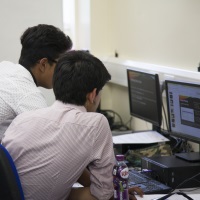Young students search for eclipsing star systems at Keele University

Twenty local students visited Keele University last week to take part in an astrophysics research project.
The pupils, from a range of schools and colleges, were hosted by the University’s astrophysics group and helped study data from NASA’s Kepler Space Telescope, in an effort to find types of binary stars that eclipse each other as they orbit. These investigations can help estimate the masses, radii and orbital separations of the stars in such systems.
Their findings will be used by Keele University’s Professor Rob Jeffries and Dr Pierre Maxted for their research programme, Project Gemini. The study is attempting to determine the factors that influence tidal dissipation in such binary systems, leading to the phenomena of ‘tidal locking’, which as an example keeps one side of the Moon facing towards the Earth, and ‘tidal circularisation’, an astronomical effect that gradually leads to elliptical orbits becoming circular.
Professor Jeffries said: “This is the second year we have run a work experience project in this way. It's a fantastic opportunity for students interested in Physics, Astrophysics and Maths to come into a university environment and see how research is actually done, practise valuable skills such as teamwork, how to use information sources in a discriminating way and how to present their findings.”
The students involved are in Years 10, 11 and 12 and are from St John Fisher Catholic College, Trentham High School, St Joseph's College, Clayton Academy, The Corbet School, St Thomas More Catholic Academy, Newcastle-under-Lyme College and the Heart of England School.

